Ceiling insulation in a house with a cold roof: types of effective heaters + installation instructions
High-quality insulation of the ceiling in a house with a cold roof reduces heat costs, reduces heating costs and increases the comfort of living. Thermal insulation is carried out in different ways, using materials that are diverse in composition and in the form of release. How to choose the best option?
We will talk about which methods are most effective in designing a system that prevents heat leakage through the ceiling. We will show you what to look for when choosing a heater. In our article you will find valuable recommendations for improving the thermal insulation characteristics of the house.
The content of the article:
The need for ceiling insulation
A cold roof is a budget and practical option for organizing the roof of a house for seasonal living. This design significantly saves construction costs, but does not contribute to heat conservation.
It is advisable to solve the issue of thermal insulation of the ceiling zone at the stage of building a house. However, insulation is often resorted to in an operated room.
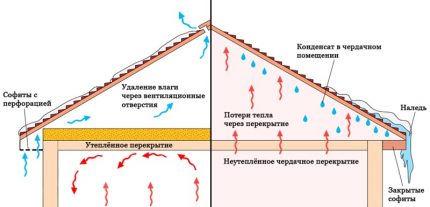
Thermal insulation of a ceiling solves a number of tasks:
- Reduces the cooling rate of heated air, helping to save heating costs.
- Increases sound insulation in the room, muffling the drone from the wind or the noise from heavy rain.
- In summer, the insulating material helps to keep the room cool, without letting in heated air from the outside.
Insulation of the ceiling increases the comfort of a private house and optimizes the microclimate of the room.Subject to installation technology, thermal insulation eliminates the appearance of condensate on structural elements.
Methods of thermal insulation of the floor
Pondering how to insulate the ceiling of the house under a cold roof, first of all, it is necessary to determine the method of thermal insulation.
There are two radically different approaches:
- insulation from the attic;
- installation of insulating material from the inside of the room.
The first method is preferable for several reasons. So, the installation technology itself is greatly simplified - there is no need to build a suspension frame or fix the insulation to glue to the ceiling.
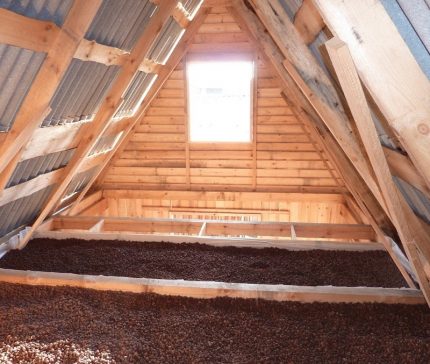
Also with this approach, the risks of condensation are minimized. You can not say about the insulation from the inside of the room.
If you choose the wrong insulation and not exclude the contact of warm air with a cold stove, then water vapor from the room will accumulate - this is fraught with the appearance of dampness, fungus and the gradual destruction of the ceiling.
However, in some situations, internal insulation of the ceiling is a necessary measure, for example:
- lack of access to the attic;
- reconstruction of an old building with a ready-made attic floor;
- thermal insulation of the garage located in the basement.
If necessary, internal insulation should adhere to the installation technology in order to prevent the appearance of condensate inside the building. It is important to observe two requirements: block the flow of water vapor and use a heater of sufficient thickness.
Review of the best heaters for the ceiling
The choice of installation method determines the list of possible options for heat insulators. When insulated by the attic, the range of materials is much larger - from natural compounds to technologically advanced solutions. Installation inside the room imposes a number of limitations.
Regardless of the placement method, insulation for the ceiling system must have low thermal conductivity. The coefficient determines the ability of the insulator to transfer energy from heated elements to cold. The lower the thermal conductivity, the better the material retains heat.
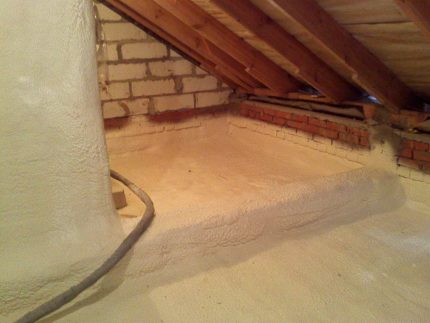
Among the additional requirements can be identified:
- durability;
- environmental friendliness and safety for humans;
- low ability to ignite - it is better to use non-combustible insulators, compositions with minimal smoke formation;
- resistance to the effects of rodents - relevant for materials placed in the attic.
It is important to take into account the indicator of vapor permeability of the insulation. But there are nuances. When insulating a concrete slab from the attic side, steam-passing material must be used. For installation from the inside of the room, on the contrary, is a vapor-proof insulation.
View # 1 - mineral wool insulation
The popular heat insulator holds the leading position due to affordability, ease of installation and good heat efficiency.
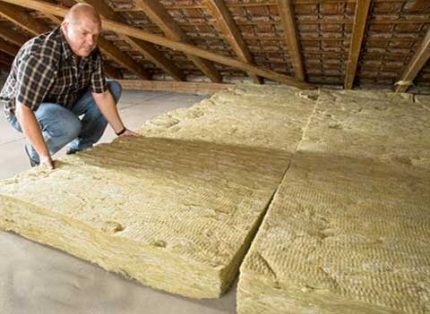
For installation under a cold roof, mineral wool with a synthetic binder, basalt insulation and glass wool are used. Maximum heat efficiency is provided by the latter option. Glass wool thermal conductivity - 0.044 W / (m ° С).
However, it should be used with caution - particles cause irritation of the skin and mucous membranes. Glass wool is not suitable for indoor use. These defects are deprived of basalt insulation.Additional advantages of the material: fire safety and ductility.
Common disadvantages of mineral wool materials:
- water absorption;
- low strength;
- tendency to shrink;
- the content of unsafe components - abrasive particles or formaldehyde resins.
To place the minvata layers, installation of wooden logs will be required, the insulation itself is preferably waterproofed from above.
View # 2 - bulk cellulose insulator
Bulk material made from paper waste and pulp. To protect against rot and fire, synthetic components are added to the ecowool.
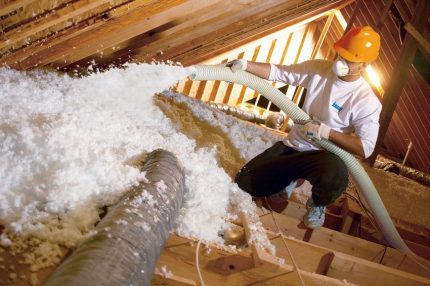
The characteristics of cellulose insulation and the technology of its application endowed the modern method of thermal insulation with a number of advantages:
- good heat efficiency - an indicator of thermal conductivity of about 0.038 W / (m ° C);
- the material fills all voids and gaps, forming a solid canvas - cold bridges are not formed;
- due to its light weight, laying ecowool of any thickness is permissible;
- longevity of service and preservation of original properties;
- environmental friendliness - ecowool does not emit toxic vapors;
- low flammability and self-extinguishing ability;
- vapor permeability.
Despite the many advantages, ecowool has not gained much popularity. The main reasons for low demand: high cost, the inability to install it yourself.
In addition, ecowool is prone to shrinkage and wrinkling - it is desirable to equip a rigid support from above to move around the attic.
View # 3 - plate polymer types
This group of insulation includes: polystyrene and extruded polystyrene foam (EPSP). Their heat efficiency exceeds the performance of mineral wool insulation. The leader is EPSP, the coefficient of thermal conductivity is 0.038 W / m ° C.
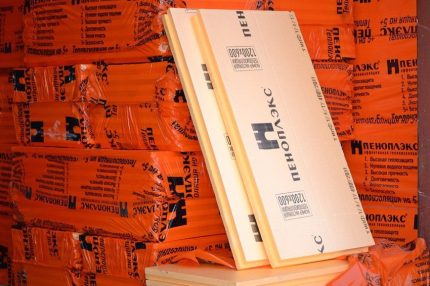
Polyfoam is cheaper than expanded polystyrene. Among the common advantages are:
- water resistance;
- low biological activity;
- wide selection of geometric sizes and thicknesses.
Both materials are vapor tight, so they are used to insulate concrete and brick surfaces.
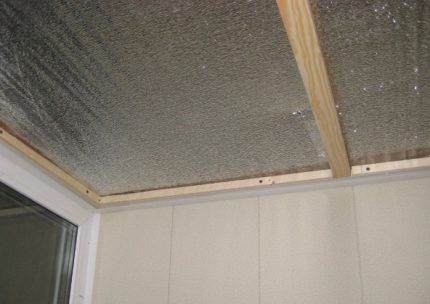
The material is suitable for indoor installation. Penofol is placed with the foil side inside the room - the canvas not only retains heat, but also partially reflects it back.
It is advisable to use foamed polyethylene as an independent material in areas with a mild climate. In regions with severe winters, the combination of penofol and penoplex shows a good effect.
View # 4 - bulk heat insulator
Lightweight porous material in the form of rounded granules. The composition contains burnt clay. The natural origin of the insulation explains its environmental friendliness.
Additional advantages of expanded clay:
- fire resistance;
- providing a good degree of sound insulation;
- durability;
- chemical inertness;
- not of interest to rodents;
- the heater does not give dust.
The thermal efficiency of expanded clay depends on the density of the embankment, the size of the granules.
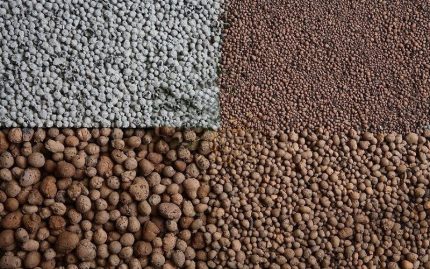
To ensure heat preservation, it will be necessary to use an embankment 20 cm thick or more, in cold regions the layer is increased to 40-50 cm. This leads to an increase in the cost of the insulation procedure and significantly increases the load on the ceiling.
View # 5 - liquid polyurethane
Polyurethane foam is fed to the surface under pressure, using a special technique for spraying.Polyurethane foam is an excellent solution for attic floors with complex terrain and thermal insulation of hard-to-reach spots.
The main advantages of foam ceiling insulation:
- the formation of a seamless tight coating;
- high adhesion with materials - polyurethane foam fills all cracks and voids;
- low water absorption;
- excellent indicator of heat efficiency due to the porous structure of the hardened foam - an index of thermal conductivity of about 0.027 W / m ° C;
- preservation of qualities in wet conditions;
- the possibility of multi-layer spraying - relevant for cold regions;
- providing acoustic insulation;
- durability of the coating - service life of about 25 years;
- processing speed;
- resistance to microorganisms;
- lightness of the material - does not exert pressure on the overlap.
Polyurethane foam is difficult to ignite, the insulation does not spread combustion.
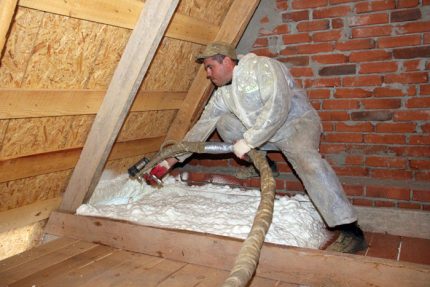
The total cost includes the price of the insulation itself and the cost of attracting craftsmen with equipment. Foam can not be sprayed if the air temperature in the attic is below +10 ° C.
View # 6 - Natural Materials
The main advantages of folk methods: affordable cost and environmental friendliness. The technique of use and the effectiveness of such natural materials as sawdust and algae are different.
Features of sawdust insulation
Bulk waste wood is often mixed with shavings and distributed over the floor from the attic.
Ways of warming:
- Dry backfill. Wooden logs are mounted on the floor, the cells are filled with sawdust. The material shrinks over time and requires periodic updating.
- Wet method. Sawdust, cement and water are combined in a proportion of 10: 2: 1.5, respectively. Such a thermal layer is more durable.
Weaknesses of sawdust: flammability, fear of rodents and water absorption.
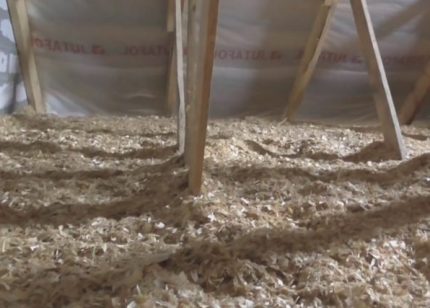
Characteristics and varieties of algae
In coastal areas, algae are widely used, the second name of the insulation is kamka. The material is natural, with good thermal insulation characteristics. Rodents do not start in algae, and the insulation itself is not afraid of moisture and does not rot.
There are three types of cam:
- weighted - bales or loose rolls collected from dried pressed algae;
- mats in nets - canvases with a thickness of 10 cm, tied with synthetic thread for ease of installation;
- solid plates - up to 85% of algae is present in the composition, the rest is a binder component, for example, silicone.
In terms of heat efficiency, the chamber is significantly inferior to many heaters, the heat capacity coefficient is 0.087 W / (m ° C).

Calculation of the thickness of the insulating layer
From the accuracy of determining the thickness of the insulation, which is part heat engineering calculationdepends on the effectiveness of thermal insulation. In addition, the indicator allows you to calculate the loads placed on the ceiling structure. In the calculation, the permissible weight and the required thermal protection are compared.
The thickness of the insulation is determined by the formula
q = R * k,
Where:
- q - the thickness of the insulating material, m;
- R - thermal resistance, m2° C / W;
- k - coefficient of thermal conductivity of the insulation, W / (m ° C).
The value of R is determined by tabular data - the indicator is calculated for each region, taking into account the climate.
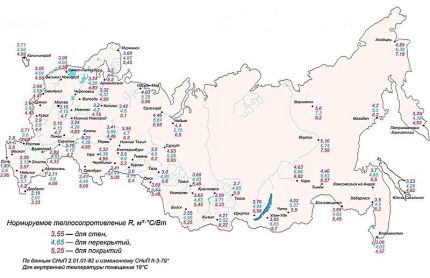
To calculate, it is enough to multiply the indicators 4.26 and 0.038. The last value is the coefficient of thermal conductivity of extruded polystyrene foam. The weighting of the ceiling is calculated based on the volume of the insulation and its density. The first indicator is determined by the product of the area and thickness of the insulation, the second is the tabular value.
The minimum load on the overlap is exerted by polyurethane foam and ecowool, their density is in the range of 25-60 kg / cu. m. One of the heaviest heaters is expanded clay - 180-330 kg / cu. m
Features of the installation of different materials
The tactics of actions depend on the selected material and its location - from the inside of the room or from the attic.
Laying mineral wool
Installation of insulation is carried out on the attic floor.
When installing a heat-insulating cake, it is important to withstand two conditions:
- to provide protection for mineral wool from water vapor coming from inside a warm room;
- arrange ventilation of the outer surface for weathering moisture from the insulation.
Mineral wool plates are laid between the beams or slats of the prepared crate. Mounting on the floor surface is possible.

The surface is cleaned of debris, if necessary, a wooden frame is built.
Further actions:
- Install vapor barrier membrane.
- Roll out rolls or place mats between the beams.
- Mount the wooden base, maintaining the ventilation gap between the insulation and hard floor.
The last stage can be missed. However, it will not be possible to walk or store things in the attic, since mineral wool cannot be pressed.
Lining from the inside with polystyrene foam
This thermal insulation option is suitable for concrete ceilings. Expanded polystyrene plates are fixed to the surface with glue and fixed with “fungi”.
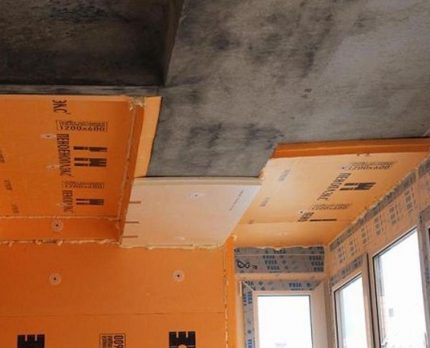
Before installing the insulation, the ceiling is treated with an antifungal composition and a primer.
The order of fastening of expanded polystyrene plates:
- Apply glue to the insulation, attach and press it to the ceiling.
- Cover the entire area with tiles, leaving no gaps between the elements.
- Drill holes for fasteners with a puncher.
- To clog fungi.
- Joints and gaps between plates to foam.
- Cut off the remaining foam, fix the reinforcing mesh with adhesive.
- Primer and plaster the surface.
After the layer has dried, peel off the ceiling and apply a decorative finish.
Filling the attic with expanded clay
The minimum layer of bulk insulation is 20 cm. To adjust the height of the backfill, it is necessary to prepare a beacon - on the piece of reinforcement make the desired mark, securing a piece of electrical tape.
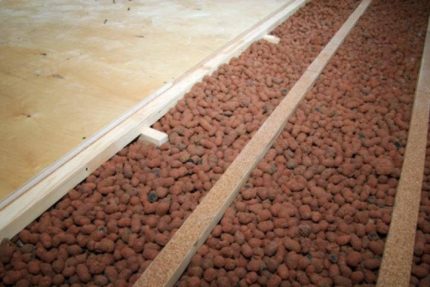
There is no need to lay a hydro barrier on a concrete base.
Work sequence:
- Pour expanded clay and evenly distribute granules.
- Check the thickness of the insulation layer. Its height should be 3-4 cm below the flooring. If this norm is neglected, then when walking in the attic, the sound of friction of the granules will be heard.
- Fix a layer of vapor barrier membrane, glue the cloth joints with tape.
- Mount a rigid base. Boards, fiberboard or OSB panels are suitable.
The floor on top of expanded clay facilitates movement in the attic and increases the effectiveness of the heat-insulating cake.
Application of spray insulation
It will not be possible to do the work on their own, since expensive equipment — a high-pressure apparatus — will be required for spraying.In addition, technical skills are needed to evenly distribute polyurethane foam.
To start the device, a voltage of 380 V is required. If there is a two-phase network in the house, a generator is connected that produces the desired value of the electric field.
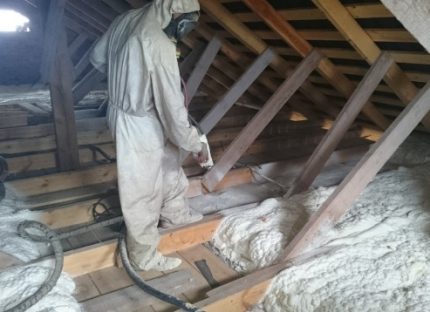
Recommended work procedure:
- Mount wooden logs on the attic floor. They will be needed for subsequent mounting of the flooring.
- Fill the device with components in the required proportions.
- Set the spray gun to its minimum foaming force.
- Apply polyurethane foam between the logs in an even layer.
- Wait for the composition to dry. If the thickness of one layer is not enough, then the treatment must be repeated.
- Level the frozen coating by cutting off the excess to the level of lag.
- Mount a rigid base on the boards.
To insulate a small ceiling with your own hands, you can use a disposable foam spraying kit.
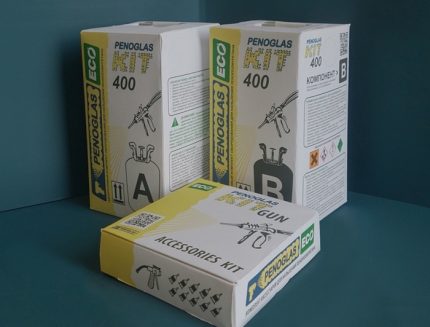
Assembly and preparation takes a couple of minutes, power sources are not needed - the device works autonomously.
Conclusions and useful video on the topic
Technology of insulation of mineral wool overlap:
Thermal insulation of the ceiling of a private house with sawdust:
Insulation of the ceiling with a cold roof is one of the conditions for comfortable and economical operation of the house. When arranging a heat-insulating layer, it is important to choose the right material. The installation method is important, as well as the mandatory formation of a reliable condensate shutoff.
Do you want to share your own experience in arranging a heat-insulating ceiling system? Have information that will be useful to site visitors? Please write comments in the block below, ask questions and post photos on the topic of the article.

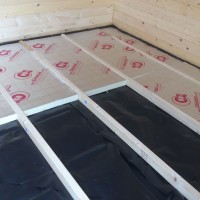 Garage floor insulation: varieties of insulation for the floor + step-by-step instructions
Garage floor insulation: varieties of insulation for the floor + step-by-step instructions 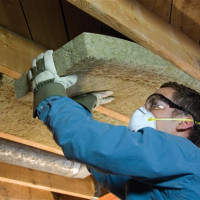 Insulation of the ceiling in a private wooden house inside and out: choosing the best material and the nuances of installation
Insulation of the ceiling in a private wooden house inside and out: choosing the best material and the nuances of installation 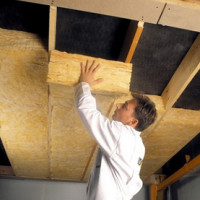 Insulation for the ceiling in a private house: types of materials used + how to choose the right
Insulation for the ceiling in a private house: types of materials used + how to choose the right 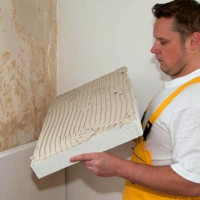 Types of insulation for the walls of the house from the inside: materials for insulation and their characteristics
Types of insulation for the walls of the house from the inside: materials for insulation and their characteristics 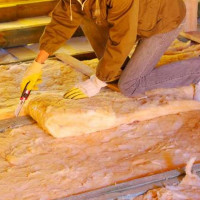 Floor insulation in a wooden house: work procedure + popular heaters
Floor insulation in a wooden house: work procedure + popular heaters 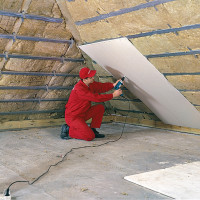 Do-it-yourself attic insulation from the inside: step-by-step instruction on insulation + tips for choosing materials
Do-it-yourself attic insulation from the inside: step-by-step instruction on insulation + tips for choosing materials  How much does it cost to connect gas to a private house: the price of organizing gas supply
How much does it cost to connect gas to a private house: the price of organizing gas supply  The best washing machines with dryer: model rating and customer tips
The best washing machines with dryer: model rating and customer tips  What is the color temperature of light and the nuances of choosing the temperature of the lamps to suit your needs
What is the color temperature of light and the nuances of choosing the temperature of the lamps to suit your needs  Replacement of a geyser in an apartment: replacement paperwork + basic norms and requirements
Replacement of a geyser in an apartment: replacement paperwork + basic norms and requirements
In my house I used two types of insulation of the ceiling - glass wool and expanded clay. In the early 90s, he laid glass wool. After 20 years, it was necessary to change the insulation, brought gas masks from work (the filters had to be thrown out after work). While the father cleared the attic, everyone cursed. The whole body was scratching. The ceiling is covered with reinforced concrete slabs, so I chose expanded clay for insulation. 15 cm of thickness in our region is enough, I hope this is the most durable option of all existing.